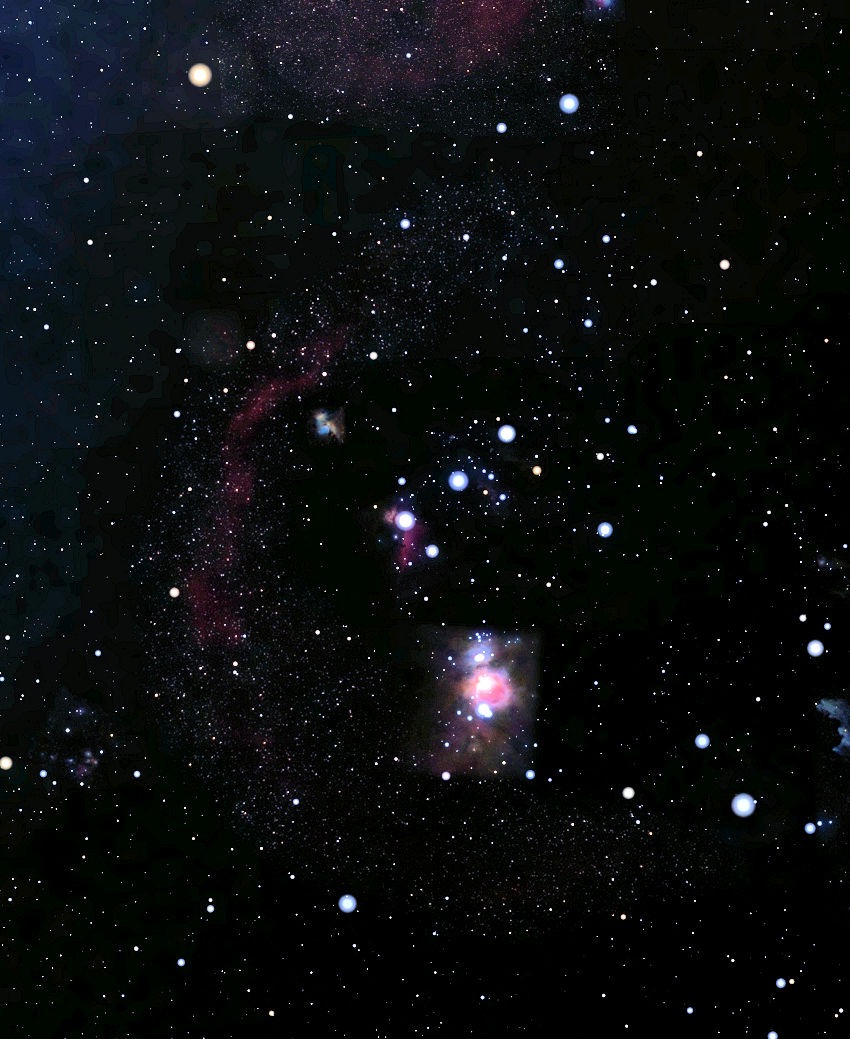Orion
The constellation of Orion the Hunter dominates the sky into February.
So it’s a good time to take a close look at this magnificent constellation.
Three stars which make Orion’s belt are at the centre of the star pattern.
Two bright stars above and below the belt make the hunter’s body.
Dimmer stars to the left and right make his club and shield.
Mythology
There are various stories about the hunter in Greek mythology.
In one version, Orion boasts that his hunting prowess is so great that he could kill all the animals on Earth.
The Earth-god, Gaia, objects to this and sends a scorpion to sting and kill Orion.
Orion is then placed among the stars, with the scorpion on the other side of the sky.
Nearby constellations are associated with the Hunter.
Behind him are two hunting dogs, Canis Major and Canis Minor, with their bright stars Sirius and Procyon.
Below Orion is a possible prey, Lepus, the dim little hare.
But Orion has his eyes on a bigger target in the shape of Taurus the Bull.
Orion and friends
First let’s take a look at the surroundings in the night sky.
For our star maps, we’re using Stellarium.
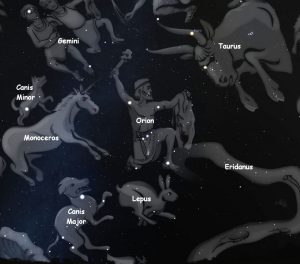
Orion and surrounding constellations. Stellarium
Orion the hunter dominates the southern night sky in January through February.
Above right is Taurus the Bull, home for a while to planet Mars.
Below left is Canis Major, the big dog.
There we see Sirius, the dog star, the brightest night time star.
Above Canis Major, dim stars make Monoceros the Unicorn.
But our eyes are drawn to Procyon, brightest star in the small dog, Canis Minor.
Above the little dog two bright stars mark the heads of the Gemini twins.
Let’s see those stars without the constellation images.
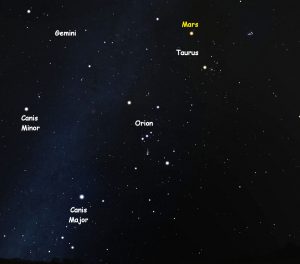
Orion and surrounding constellations. Stellarium
Orion
Now we focus on Orion himself.
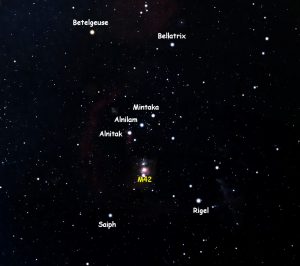
Orion. Stellarium
The primary stars of Orion are each remarkable in their own right.
We’ll begin with the three stars in his belt.
From left to right, they are Alnitak, Alnilam and Mintaka.
Alnitak, ‘the girdle’ is around 1200 light years away.
It is a very luminous blue giant star.
Alnilam, the ‘string of pearls’, is another blue giant.
It’s half a million times more luminous than our Sun.
Its light is dimmed by its distance of 2000 light years.
Mintaka, ‘the belt’, is another blue supergiant, like Alnitak some 1200 light years away.
So the three belt stars are all blue supergiant stars.
The trend continues with the two bright stars below.
The star on the right is Rigel, around 850 light years distant.
It is 70 times wider than the Sun and shines 100,000 times brighter.
To the left is Saiph, 650 light years away and 50,000 times brighter than our Sun.
Now we look at the two stars above Orion’s belt.
On the right is Bellatrix, ‘the female warrior’.
This hot blue giant is 5 times the size of the Sun.
The top left star is Betelgeuse.
It too was once a blue supergiant star like the others in Orion.
But Betelgeuse has used up its hydrogen fuel.
When this happened, it swelled up to become a red supergiant star.
If Betelgeuse replaced our Sun, its surface would be beyond the orbit of Mars.
Betelgeuse is living on borrowed time.
At some time in the future, it will explode as a supernova to become a black hole.
Indeed this is the fate of all seven superstars that make the outline of Orion.
It really is a most amazing set of stars.
The Nebula
We now turn away from star death to look at star birth.
We have arrived at the Orion Nebula.
To find it, simply look below the belt.
There you’ll see a hazy glow, the gas cloud of the Orion Nebula.
Through a backyard telescope you see a grey, fan-shaped patch of light.
Long-exposure photographs bring out the colours and the true glory of the nebula.
Quick Facts
Catalogue number: M42
Distance: 1350 light years
Size: 25 light years across
Apparent magnitude, m: +4.0

The Orion Nebula Credit: NASA / ESA Hubble Space Telescope
The gas is mainly hydrogen.
Light from stars within the nebula ionises the hydrogen, making it glow like a fluorescent light.
Hydrogen emits red light. M42 is an emission nebula.
Within the gas are dark lanes of interstellar dust.

Central area of M42. NASA/ESA Hubble Space Telescope
At the heart of the nebula are four stars called the Trapezium Cluster.
These young stars are responsible for lighting up the nebula.

Trapezium Cluster. Optical (left), Infrared (right) NASA/ESA Hubble Space Telescope
Within M42, new stars are being born.
Gravity collapses part of the gas cloud.
The hydrogen becomes denser and hotter.
Eventually nuclear fusion begins, turning the hydrogen into helium.
A new star is created.
More Nebulae
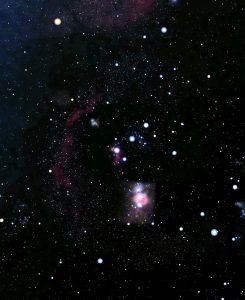
Nebulosity in Orion. Credit: Stellarium
Interstellar gas pervades the whole of Orion.
Zooming in with a telescope reveals more iconic nebulae.
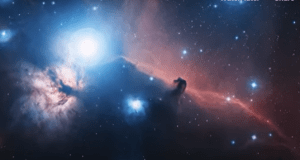
Horsehead and Flame nebulae. Hubble / NASA / ESA
Just below Alnitak, the left star of the belt, is the famous Horsehead nebula.
We see an intrusion of dust into bright gas in the shape of a horse’s head.
To the left is a bright area of light emission.
This is the Flame Nebula.
Exploring Orion
Exploring Orion with a telescope is very rewarding.
Bright stars, superstars, star clusters. glowing gas, swirling dust can all be found in this king of constellations.
Orion and the Moon
The advent of Spring will see constellation Orion disappearing from our sky.
However his namesake will make news this year.
Orion is the name of the spacecraft that will return people to the Moon in the Artemis mission.

Orion crew capsule. NASA
In 2023, the Orion capsule will carry astronauts on a test flight.
In 2025 it will hopefully take humans back to the Moon.
The Artemis programme will feature in our blog next month.
Enjoy looking up and watch this space!
The author: Dennis Ashton is a Fellow of the Royal Astronomical Society and a Wonderdome presenter.
Would you like to hear more Astronomy news?
Do you want to to find out about our upcoming public events?
Follow WonderDome Portable Planetarium on Twitter and Facebook or go to our web site wonderdome.co.uk

